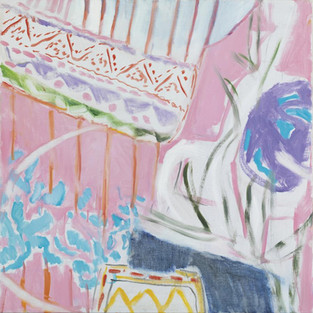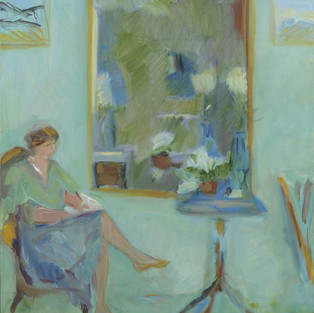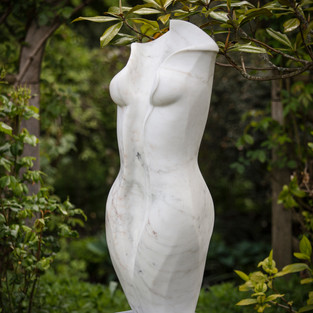Celebrating Women in Art
- Messum's Studio

- Mar 8, 2021
- 6 min read
Updated: May 9, 2024
Rose Hilton (1931-2019)

David Messum comments "Roses’s late blooming as an artist is well documented but, whilst an enormous achievement in itself, her greatest triumph I often feel, was to be not only the muse to her artistic husband Roger Hilton but to bring up their two boys, run their household and cater to a bed ridden partner who was, not so quietly, smoking and drinking himself to an early grave.
In all the time that I have known her she was never to complain about her lot in life, she had already tasted success before she met Roger, and her cheery presence was intoxicating. This sort of strength is not so easy to talk about but you can glimpse it in her pictures. There are no hard edges to her subjects most of which are life drawings. She relished her artist’s model their presence in her studio adding to the intimacy of her work. Charcoal lines help to distinguish form but colour creates the energy in soft feminine tones put in with flare and with ease or so it would appear. One could never be quite certain if the picture was finished but there by hangs the magic as they always left you wanting more I thought. It was the same in meeting her picking up with easy grace from a previous meeting and letting go when time ran out."
"Rose Hilton had, for me, sublime strength which demanded great respect."
David Messum
Paintings by Rose Hilton are available on www.messums.com
Above: Watch the Messum's film which visits Rose in her studio
Lucy Kemp-Welch (1869-1958)
Lucy Kemp-Welch was the first female artist to be purchased for the Tate Gallery collections in 1897.

Lucy Kemp-Welch is best known for the paintings of horses in military service she produced during World War One and for her illustrations to the 1915 edition of Anna Sewell's Black Beauty, an achievement in itself. However, if she is placed in the historical context of the traditions of art history during the late 19th Century and early 20th, her achievements are quite extraordinary and she undoubtedly helped to develop the way for future generations of women artists.
Lucy grew up in Bournemouth where she was encouraged to draw and study the ponies and wildlife of the New Forest. In 1892 she was admitted as a student of the Herkomer Art School where she went on to become the most distinguished female graduate of the School. She also became the first President of the Society of Animal Painters and one of the first two women members of the Royal Society of British Artists. Kemp-Welch quickly developed a reputation for painting horses culminating in the honour of having her painting 'Colt Hunting in the New Forest' acquired by the Chantrey Bequest for permanent display at the Tate Gallery in 1897 which was the first work acquired from a woman.

During the First World War, women worked at Army Remount Depots to train horses for military service. Lucy was commissioned by the Women’s Work Section of the Imperial War Museum to paint a scene at the largest depot at Russley Park in Wiltshire.
"According to The Times Obituary, 28 November 1958: ‘For this picture she sat with her easel on Salisbury Plain while eight batteries of horse artillery were driven towards her so that she could sketch the general outline of their movement.’"

From these sketches, she developed the masterpiece “Forward the Guns” which was shown at the Royal Academy in 1917 and was later purchased by the Chantrey Bequest for the Tate Gallery.
The Studio Estate of Lucy Kemp-Welch has been represented by David Messum since 1972, since when there have been a number of successful exhibitions and publications leading to her artistic reappraisal.
Lucy Unwin b. 1984
"A Celebration of the Female Form - soft and feminine lines carved from monumental pieces of Italian marble"

“The inspiration for my work derives from natural forms, be it organic shapes found in nature or the human figure. When working with stone I use the natural shape of the material for guidance before releasing the form within. The physical process of working, which is often very demanding is important to me, as by combining physical and mental energy I am able to create the desired outcome.”
Lucy Unwin's obvious love for the countryside, her upbringing on a farm and family holidays by the seaside have all fed into her interest in nature, and her stone carving of shells and fossils has already made her a respected name. Pushing the boundaries in all that she has achieved in her life, both as an athlete (she played for England in the womans’ under eighteens hockey team), and as a Sculptor, her sculptural stone carvings are of the finest quality. Her previous love of carving fossil shapes has now developed into more sensual forms, prompting thoughts of renewal and femininity.
Above: Watch the Messum's film featuring David Messum visiting Lucy in her studio and examining recent work.
Nancy Delouis b.1941
"Beneath the surface of her works is a genuine sense of reserve; women read, reflect, work or bathe, alone or in groups, but always with an air of calm self-possession."

It was the renowned London jeweller, Elizabeth Gage, MBE, who in the mid 2000s first brought Nancy Delouis to David Messum’s attention and Delouis’ bright, exuberant oil paintings and drawings have been a regular feature of our exhibitions for over a decade now.
The overwhelming delight of Delouis’s paintings comes from the liberating power of colour and form, her interior scenes and still lifes incorporate the exotic and the exquisite, interweaving patterns and textures, often incised into the surface with the point of her brush. Nevertheless, beneath the surface of her works is a genuine sense of reserve; women read, reflect, work or bathe, alone or in groups, but always with an air of calm self-possession. One might even think these women would still exist if we were not there to admire them. This distancing arguably also extends to her more social groups: women gathered in a West African marketplace or a japonisme interior. These works often give almost equal weight to both figures and objects, allowing them to enter into a lively dialogue of colour, form and pattern.
Above: a selection of works by Nancy Delouis - for more information visit www.messums.com
Art historian, critic and writer Ruth Millington has written on the subject of women overshadowed by their artistic husbands, which is well worth a read: Read Here
David Messum Fine Art: "Ruth, on this special day when we can celebrate and shine a light on female artists, what are your thoughts having researched and studied the subject?"

Ruth Millington: "For too long, art history has ignored female artists, who have been eclipsed by men, including their own husbands. Tirzah Garwood (1908-1951), Lee Krasner (1908-1984), Ana Mendieta (1948-1985), Jo Hopper (1883-1968) and Elaine de Kooning (1918-1989) are just a handful of women who have been overshadowed by their male partners. While many female artists have failed to receive recognition for their work during their lifetimes, it’s not too late for us to honour them now – telling the true stories of women who launched movements,
pioneered new styles, painted secretly in attics, and protested through art".
We asked gallery staff to comment on their favourite women artists and we welcome comments and ideas on the subject from our readers:

CHESKA HILL-WOOD - Sales Director
The American artist Georgia O’Keeffe (1887-1986) with her classic aesthetic of enlarging and showing the beauty in small, natural details, was one of the first women to receive acclaim from both the critics and public alike. As a result she was the first female artist to have a one-woman retrospective at MOMA in the 1940s.
Her work is most identified by her New Mexico landscapes, skulls and the iconic flower paintings; Jimson Weed/White Flower No. 1 painted in 1932 set the auction record for a female artist, realising $44m in 2014.

She was a free spirit who was unapologetically true to her own vision.
Maybe one day we will be able to see this as ‘normal’ instead of ‘brave’.
KATIE NEWMAN - Managing Director

Wilhelmina Barns-Graham (1912-2004), or Willie to those that new her, is an example of one of these fascinating female artists whose worked ‘bloomed’ late in life. She turned eighty and there was a sudden burst of colour and 'joie-de-vivre' and an outpouring of paintings and prints, reflecting in her own words, a form of “letting rip.”
She achieved this as an octogenarian and it makes me think there is hope for us all!!

JO ORCHARD - Projects and Design Manager

My favourite female artist is Nancy Rose Taplin. As I come from a background of book designers and as a very keen 'birder' myself I find Nancy’s work utterly irresistible. She heralds from a very artistic family, her father is Guy Taplin the bird sculptor and her mother is Robina Jack, the wonderfully talented ceramicist.
Nancy’s work is intricate and delicate - every feather carefully formed until the personality of the bird is revealed on the foxed and blotted surfaces of the old books and ledgers she chooses to repurpose.























Comments